Keeping in touch with your customers is essential if you want your business to thrive. The best way to boost sales is by regularly sharing valuable, relatable content that keeps your brand fresh in their minds. While email newsletters are popular, they’re definitely not your only option.
That’s where WhatsApp comes in. It’s one of the most widely used messaging apps globally and provides businesses with powerful tools to connect directly with customers. In this post, we’ll explore how you can create WhatsApp newsletters that grab attention, keep your audience engaged, and drive meaningful results.
What is a WhatsApp newsletter?
A WhatsApp newsletter is a bulk message sent to multiple subscribers via WhatsApp. Similar to email marketing campaigns, these newsletters let you share updates, product launches, promotions, news, and other valuable content directly with your audience. Unlike group chats where everyone can reply, WhatsApp newsletters arrive as private messages in each subscriber’s inbox.
Basically, small businesses can easily send WhatsApp newsletters to a limited audience using broadcast lists through the WhatsApp Business app. However, if you want to scale your campaigns and access advanced tools, such as automation, customer segmentation, scheduling, and personalized messaging, you’ll need to use the WhatsApp Business API.
Why should businesses send WhatsApp newsletters?
Now that you know what WhatsApp newsletters are, let’s explore why they can be valuable to your marketing strategy. We’ll list a few key benefits WhatsApp newsletters offer for businesses.
High engagement and open rates
WhatsApp messages have an exceptional open rate of over 90%, and around 80% of messages get read within the first five minutes. These numbers truly speak for themselves. Unlike emails, which can easily go unread or get lost in spam folders, WhatsApp newsletters appear right in your customers’ chats, feeling more personal and urgent, which prompts quicker reactions and actions.
Personalized communication
WhatsApp newsletters offer recipients a highly personalized experience and are an excellent way to build stronger customer relationships. You can address customers by name, reference their past interactions, and send tailored content based on their preferences or past purchases.
Various media formats
Using WhatsApp, you are not limited to plain-text messages. The platform lets you create visually appealing and engaging campaigns by adding images, videos, PDF files, interactive buttons, and voice notes.
Cost-effectiveness
Compared to traditional marketing channels like SMS or paid ads, a WhatsApp newsletter is a worthwhile way to reach larger audiences. You can often send campaigns at no extra charge under certain conditions. Additionally, higher open rates and engagement typically mean your return on investment will exceed that of other marketing strategies.
Automation and scalability
The WhatsApp Business API allows your business to scale efficiently through automation. You can create chatbots to handle common scenarios, set up automated flows, collect payments, showcase products, and schedule your newsletters in advance. This helps you reach more customers with less manual effort.
Tips on how to create effective WhatsApp newsletters
Creating WhatsApp newsletters requires a balance of value, engagement, and the right strategy. Here are some tips to maximize the impact of your newsletter:
- Define your goals. Before creating content, clearly define your goals. This could include promoting new products, announcing events, or offering exclusive perks. Having a specific goal in mind will guide your content strategy effectively.
- Segment your audience. Relevance is key to engagement, so segment your audience to send targeted messages instead of identical ones to all your contacts. Consider leveraging personalization: use names, reference recent customers’ interactions, or mention particular products they are interested in whenever possible.
- Keep it short. WhatsApp is a messaging platform, so your newsletters should feel natural and conversational. Try to hook subscribers in the first line to motivate them to continue reading.
- Use multimedia. Make use of the variety of files that WhatsApp supports. You can mix images, GIFs, videos, and voice notes if necessary. Infographics and short clips can also boost user engagement.
- Add a clear CTA. Always use strong, direct language to make your call-to-action effective. Phrases like “Click here,” “Reply YES,” or “Visit our site” guide users toward action and boost conversions.
- Maintain consistency. Set a regular schedule for your WhatsApp newsletters so recipients know when to expect them. Whether it’s weekly or bi-weekly, consistency builds anticipation with subscribers.
- Optimize for mobile. Since most recipients will view your newsletters on mobile, create messages with short paragraphs and bullet points and avoid large text blocks for better readability.
- Comply with WhatsApp policies. It’s crucial to familiarize yourself with all the guidelines to prevent your account from getting blocked. In particular, you can only send WhatsApp newsletters to users who have opted in and have to employ pre-approved message templates if users haven’t interacted with your chat for over 24 hours.
- Monitor and improve. It’s vital to track the effectiveness of any marketing campaign; WhatsApp is no exception. Monitor your opens and responses and gather customer feedback to refine your content, schedule, and offers.
By following these tips, you can set up compelling WhatsApp newsletters that align with your brand’s objectives and offer value to recipients. Make sure to test and determine what works best for your needs.
5 examples of WhatsApp newsletters
In this section, we’ll explore some WhatsApp newsletter examples from different industries and companies, including a kitchen manufacturer, a skincare brand, a global marketplace, and apparel retailers, to inspire your campaigns.
Breitschopf
Breitschopf is a family-run kitchen business with main markets in Austria and Germany. The company doesn’t send WhatsApp newsletters frequently. Instead, they reach out to customers during promotions, giveaways, or when introducing new products to their assortment.
Breitschopf enriches its messages with quick-reply buttons and links to guide users to relevant blog articles or website sections. On top of that, the brand engages subscribers with quizzes to understand the audience better and segment prospects and customers based on their kitchen design preferences.
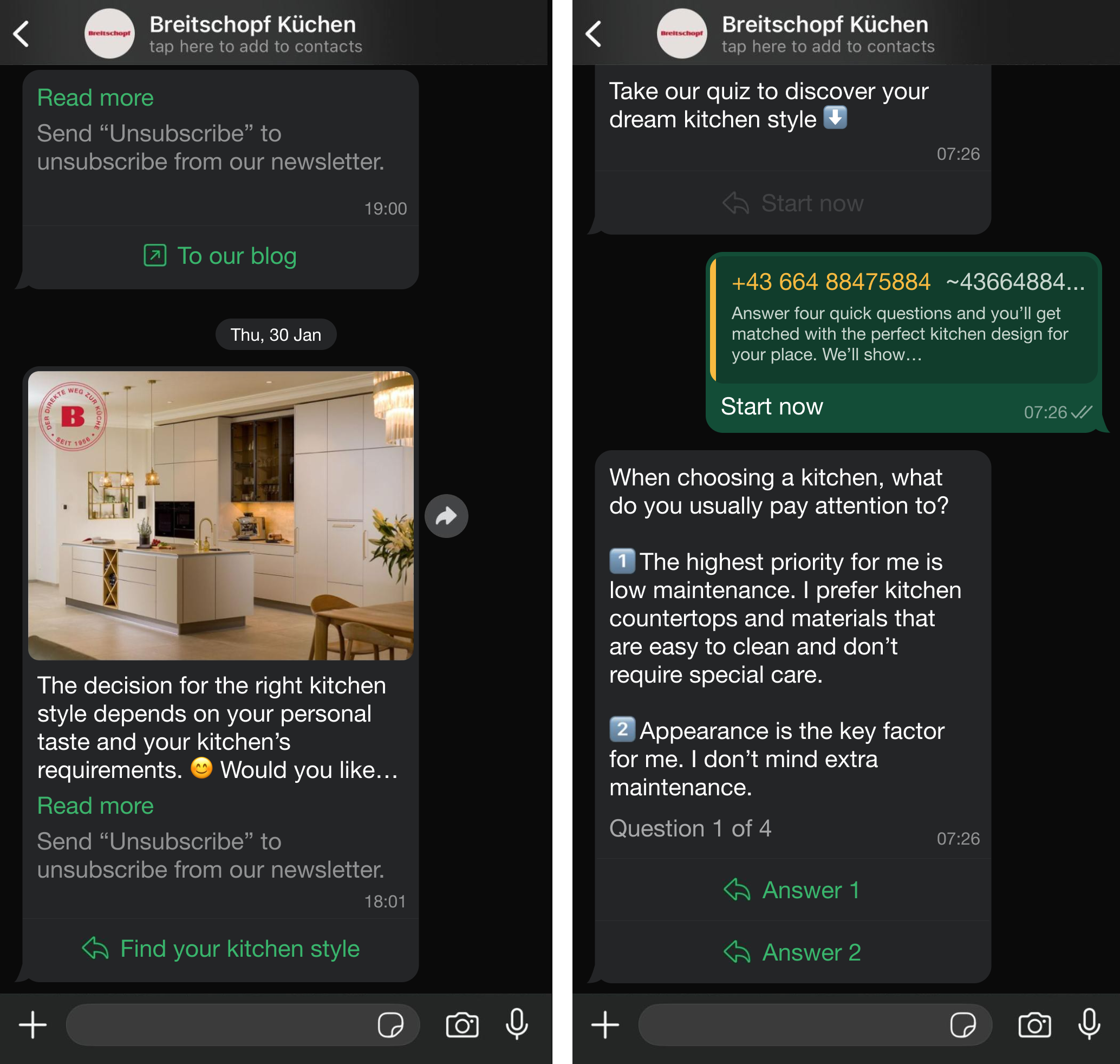 An example of WhatsApp newsletters from Breitschopf
An example of WhatsApp newsletters from Breitschopf
Snocks
Snocks is a lifestyle brand for basics that operates in Germany, Austria, and Switzerland. The company uses WhatsApp for newsletter campaigns and as a chat for customer support.
When users initiate a chat, Snocks replies with a link to contact their support team and asks if they would like to subscribe to their newsletters. As a small incentive, they offer a 10% discount to new subscribers and clearly outline the type of content they can expect.
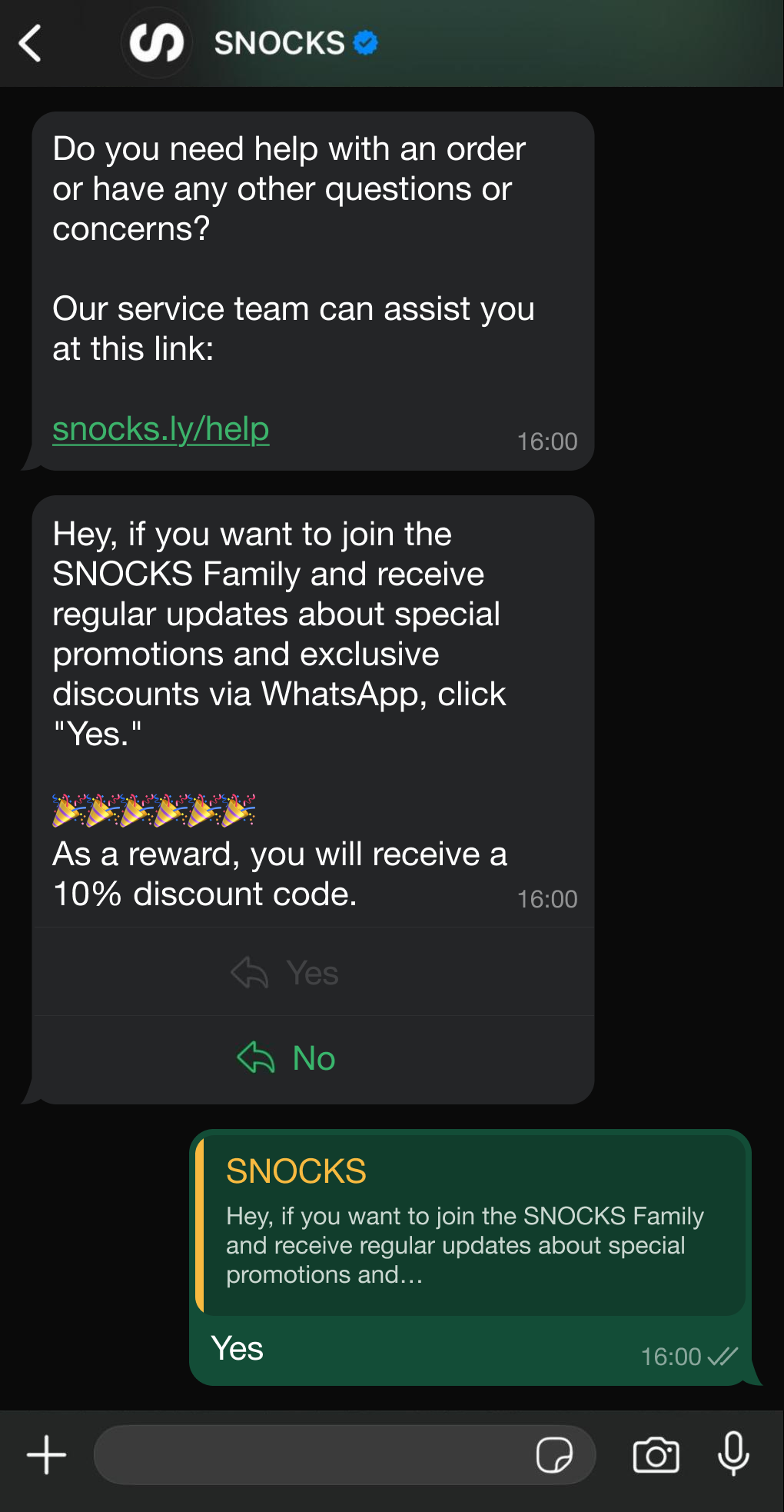 Signing up for WhatsApp newsletters from Snocks
Signing up for WhatsApp newsletters from Snocks
Form-on
Form-on is a global marketplace where you can sell and purchase second-hand formwork and different formwork components. It regularly sends promotions, limited-time offers, and exclusive deals through WhatsApp to inform its audience about the latest offers. The company uses short messages and direct links to make it easy for customers to visit its online shop and explore discounted products.
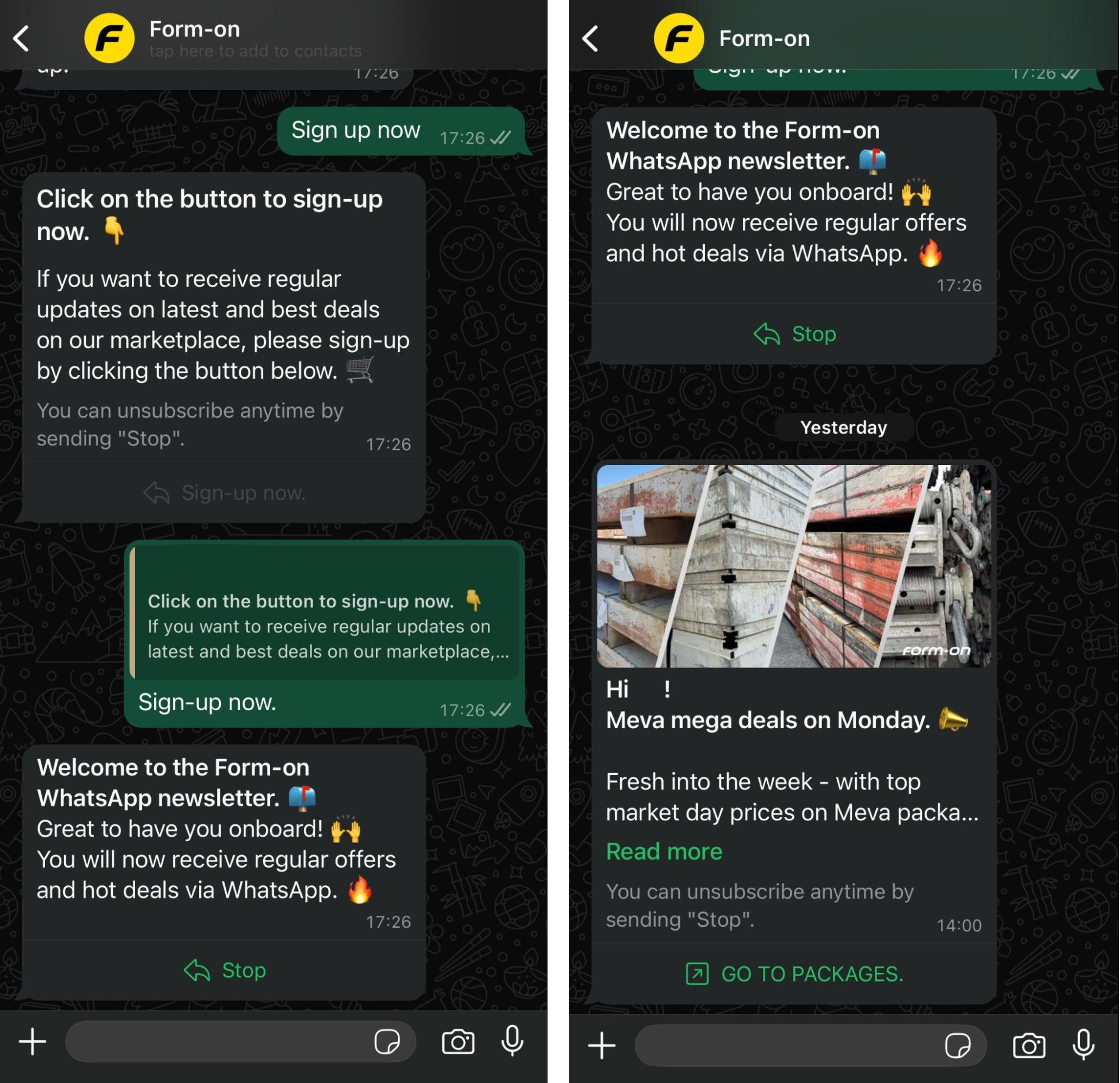 A WhatsApp newsletter example from Form-on
A WhatsApp newsletter example from Form-on
Jack Wolfskin
Jack Wolfskin is a German manufacturer of outdoor wear and equipment. The company uses WhatsApp newsletters to share regular promotions and exclusive deals while ensuring a personalized experience for its subscribers.
The company asks targeted questions about gender, interests, and preferences to segment its audience from the start. This way, Jack Wolfskin can make its WhatsApp newsletters more customer-focused by recommending relevant products and offering tailored deals. There is also a welcome €10 voucher for new subscribers to motivate them to purchase.
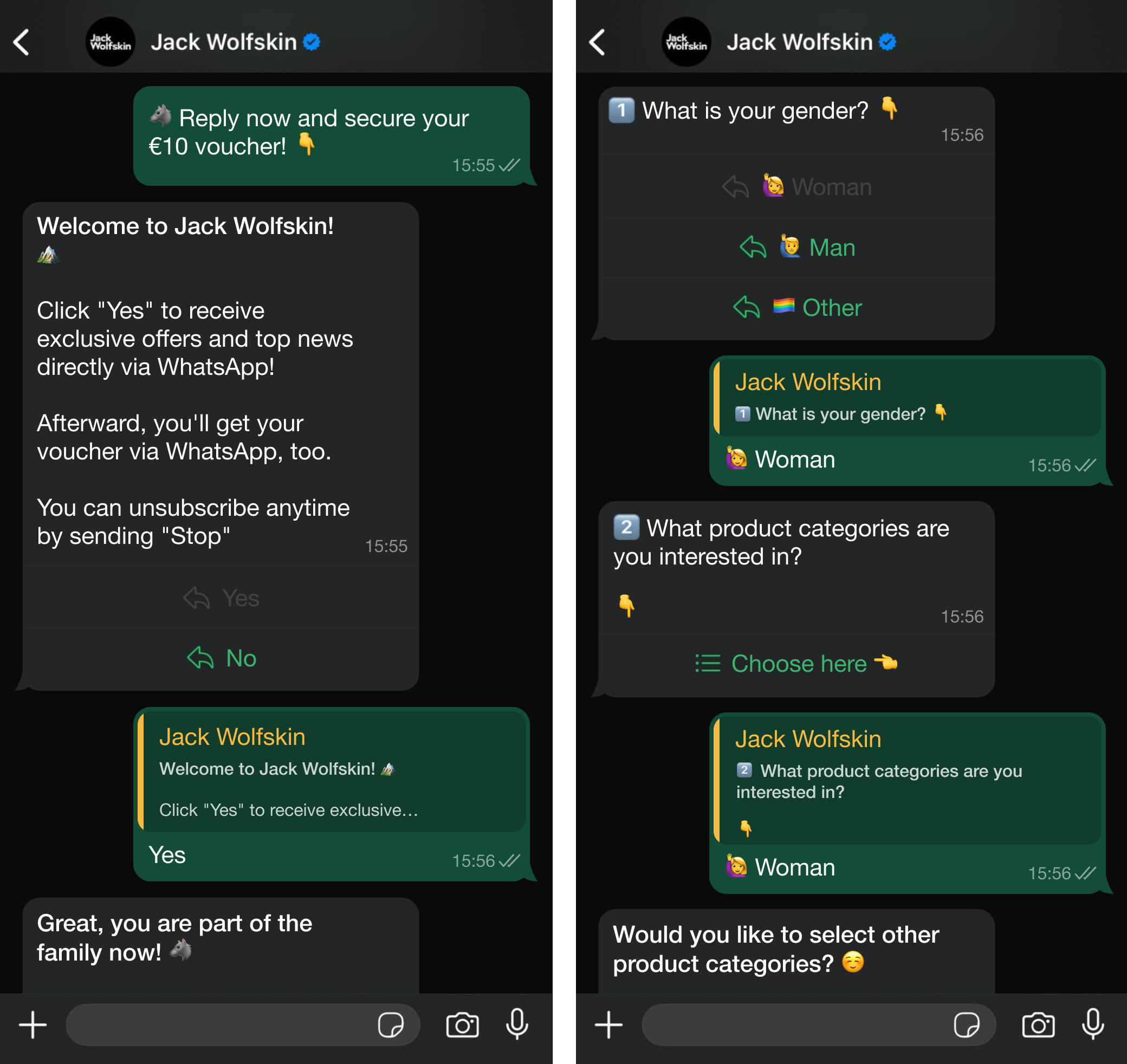 Questions by Jack Wolfskin to segment new subscribers on WhatsApp
Questions by Jack Wolfskin to segment new subscribers on WhatsApp
Dermalogica
Dermalogica is a professional-grade personal care brand. It uses WhatsApp newsletters to share exclusive deals and promotions while personalizing its customer’s experience.
When chatting, the brand collects email addresses, birthdates, and skincare concerns to tailor future offers and promo campaigns. This approach helps the company engage subscribers with content that matches their needs perfectly.
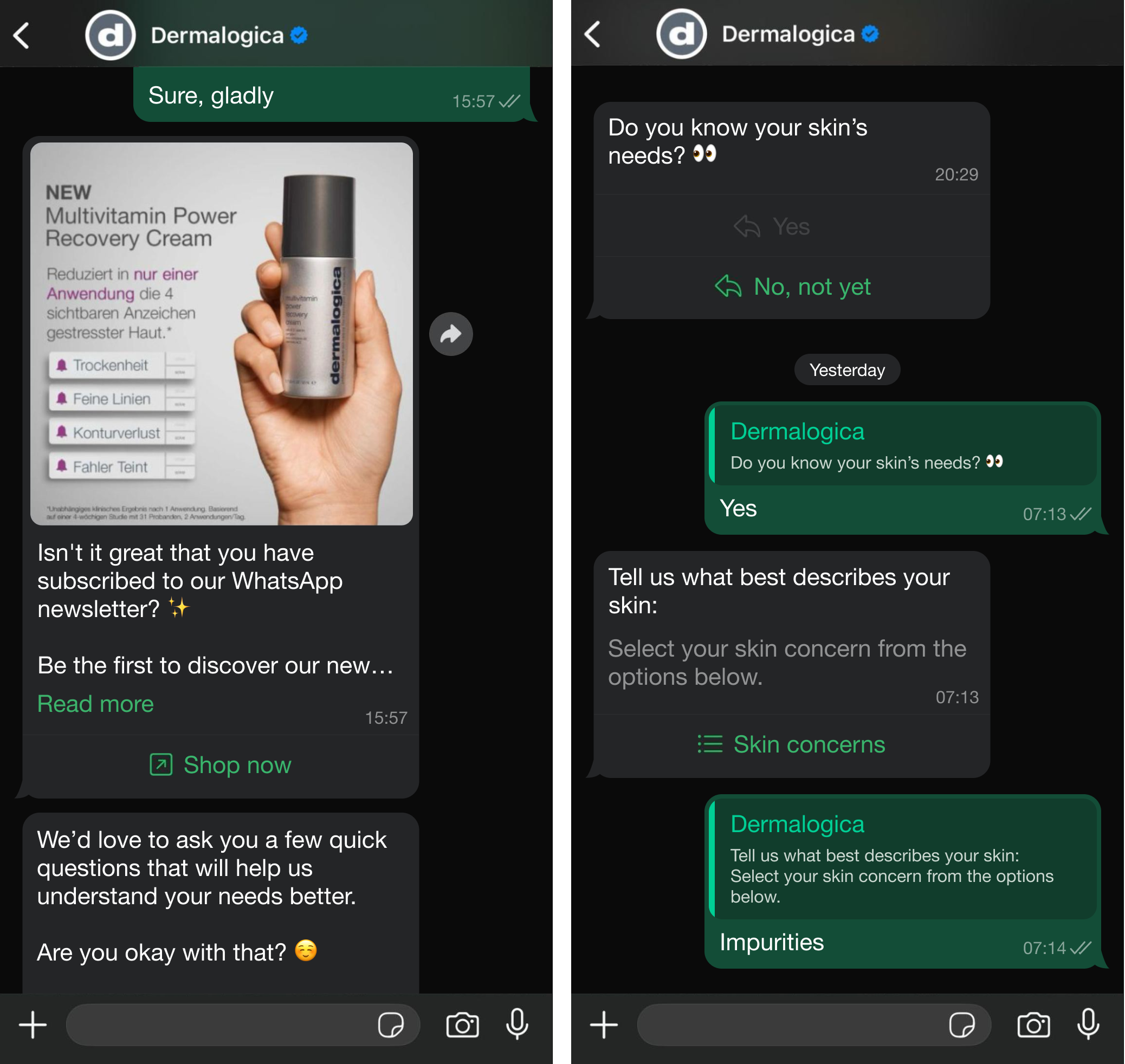 Dermalogica asks questions to personalize WhatsApp newsletters
Dermalogica asks questions to personalize WhatsApp newsletters
How to create WhatsApp newsletters in SendPulse
To send large-scale WhatsApp newsletters, you’ll need a WhatsApp Business Platform solution. SendPulse, an official WhatsApp Business API provider, lets companies connect the WhatsApp business number for professional campaigns without any setup fees. It also supports pre-approved template messages, AI-based chatbots, product catalogs, payments, and more. Let’s break down how to create your campaigns with this WhatsApp newsletter tool.
To create a WhatsApp campaign, navigate to the “Chatbots” section and click “Create campaign.” Select a previously connected bot from the drop-down list; your campaign will be sent to the audience associated with it.
When setting up your campaign, you can target all your contacts or focus on those who have been active in your chat within the last 24 hours. Besides, you can segment recipients by subscription date, tags, participation in chatbot flows, and other criteria like country, phone numbers, names, etc.
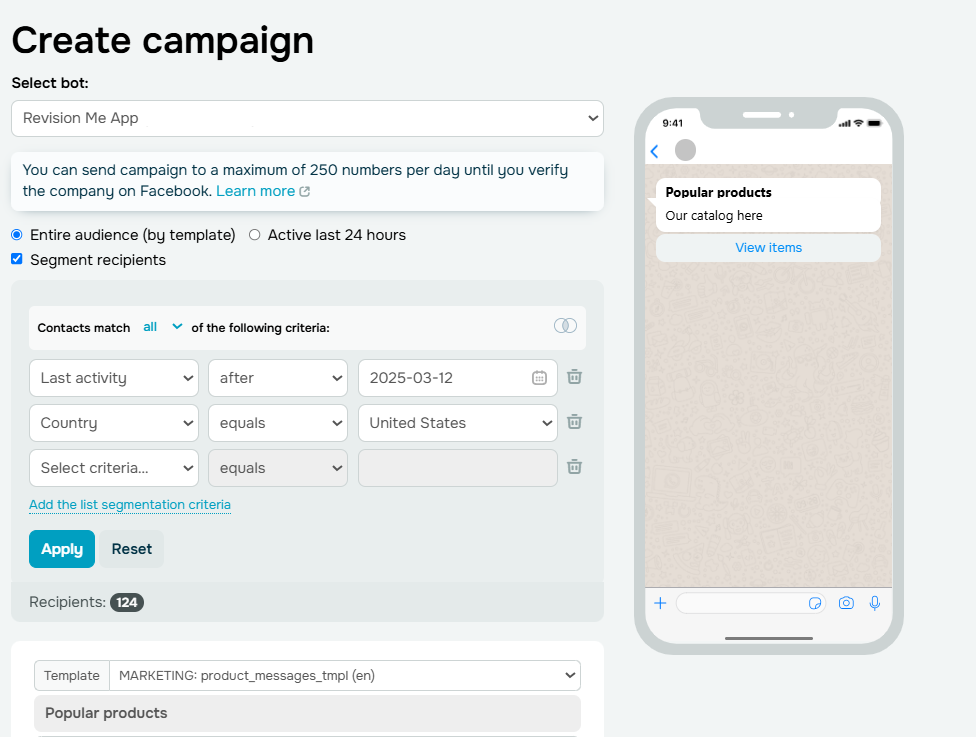 Segmenting audience by last activity, country, and other criteria in SendPulse
Segmenting audience by last activity, country, and other criteria in SendPulse
With the WhatsApp newsletter tool, you can use a pre-approved template and replace variables with your selected values. Alternatively, you can send a customizable campaign for free to active contacts, which means you can edit the text and add variables, emojis, and elements like images, files, and buttons.
Buttons can be used to continue the flow, redirect users to a specific page, or process payments within the chat.
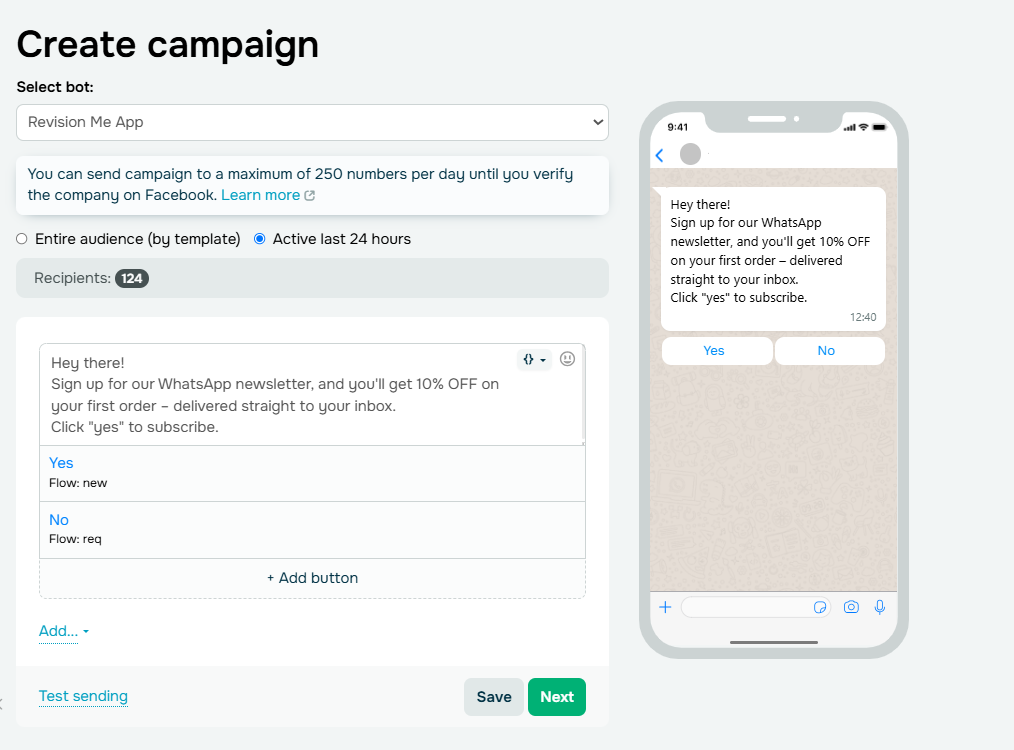 Customizing a campaign to active contacts in the WhatsApp newsletter tool
Customizing a campaign to active contacts in the WhatsApp newsletter tool
Lastly, you have to choose whether to send your WhatsApp newsletter immediately or schedule it for later. You can also send a test campaign and view the cost of sending your message.
Once your newsletter is out, you can analyze its performance by checking delivery rates, interactions, and campaign costs in the dashboard.
The bottom line
WhatsApp newsletters give businesses a powerful opportunity to engage customers directly, offering high open rates, personalized communication, and multimedia-rich content. By defining clear goals, segmenting audiences, and leveraging automation, businesses can create highly effective WhatsApp campaigns that drive engagement and conversions.
With tools like SendPulse, you can set up and manage your WhatsApp newsletters to stay connected with your audience in a meaningful and scalable way. Besides, the platform offers you an in-built CRM system to store all the important information about your customers and their interactions with your business, advanced email marketing service with a generous free plan, and other valuable tools to automate your sales pipelines and convert more leads into loyal customers.
Create your free account and explore our powerful toolkit. No credit card is required to get started.